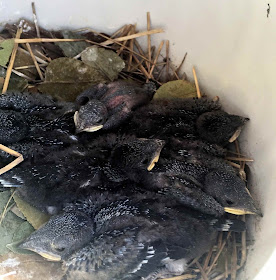By Beth Sullivan
Those of you who have read this blog
for a while have come to expect a Martin update around this time of
year. I have shared my journey and passion ( maybe obsession) with
these birds for several years now, since our first grant award in
2013 from Audubon Connecticut, to start our colony.
Purple Martins are the only species
of bird that is completely reliant on humans for their survival. We
provide adequate nesting sites which are hollows, in a colonial
setting. We just don’t have enough empty tree holes in close
enough proximity to satisfy the needs of dozens of pairs of these
birds. Since pre-colonial days, Native Americans provided natural
gourds for Purple Martins. Now there is an entire industry built
around attracting and providing for colonies of these birds, and the
effort has brought the species back from the brink of being
extirpated from many areas.
 |
| Perfect habitat for Purple Martins can be found at Knox Preserve. |
The Knox Preserve colony
At Knox Preserve we provide two set
ups, totaling 24 gourds. A close neighbor has a classic Martin House
also hosting 12 pairs. Since the end of April, when we set up the
housing, we monitor it. Early scouts come to check out the area.
Mature birds come first, usually males, to stake out their spots from
previous years. If they have a successful breeding experience in a
location, they will be very loyal to their site. Females join them,
and then younger birds, the hatchlings from the previous year, return
later. They often find no room at the inn, so they are likely to fly
farther looking for new colonies and vacancies.
As Martin landlords, we have teamed
up with the DEEP to band these birds each year for the last four, in
order to be able to identify and study them as they move between
nesting grounds and wintering grounds in South America. By fitting
them with an aluminum band with a unique number, much like our Social
Security number, these birds are identifiable as specific
individuals. That number is often difficult to discern, however,
color banding is a way to visually mark these birds so they can be
easily traced to a particular colony. Each colony in CT has a unique
color combination: Ours at Knox is Orange/Green. Nearby Pequot Golf
Course is Orange/Blue. It has been very easy to see when our
populations intermingle, which is great.
 |
| The banding team weighs, ages, and assesses health, as well as placing the bands. |
 |
| Showing off its new bands, this little one goes back into the nest. |
On a blazing hot, humid day last
week, the DEEP team arrived at Knox Preserve, efficiently set up
their work station under a tent, and got to work. It was our job as
landlords to get the birds out of their nests and delivered to the
table for processing. It is a very precise practice using Coolwhip
containers with little handmade liners for transport. Each
individual was weighed and observed carefully for development in
order to assess age and overall health. Our Colony had birds that
were as old as 19 days, yet we had one nest that was only hatching
that day - way too little to band.
 |
| A beautiful, typical nest. |
 |
| These are day-old hatchlings. |
The birds were fitted with bands and
all data recorded accurately to be later added to a full database for
all colonies. Each little one needed to remain with its nest-mates
and returned to its exact nests in an appropriately marked Coolwhip
container. The parents waited patiently, often with an insect in
their mouths, ready to fill a hungry mouth on return.
 |
| These are about a week old. |
Several of us had done this process
a number of times, yet it never ceases to be amazing. This year we
had several new observers, including a two year old who was able to
peek inside the nest and see the babies and even touch one. Other
volunteers were able to participate in the banding process. It
doesn’t matter how old you are, or how often we do this, it is
always so awe-inspiring.
It takes a lot of work, to prepare
nests and monitor them frequently, to collect data even before the
banding day. Cleaning out the gourds at the end of the season is
really an awful job. But getting to see my babies fledge and fly off
to the nearby trees makes it worthwhile.
 |
| They get little feathers before they are two weeks old. |
It is even
better to spot one with Orange/Green color bands , coming back to
the colony it where it was born, and calling it home again.
Photographs by Kent Fuller, Beth
Chapin, Jim Sullivan, and Beth Sullivan.

No comments:
Post a Comment